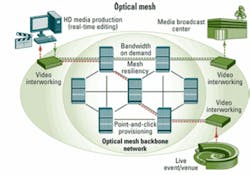by Rad Pathalam
Changes are happening all around us, and today they are happening more and more in high definition (HD). From Tiger's opening tee shot at the Masters to the Olympic feats streaming from Beijing's Bird's Nest, HD production and broadcast technologies have paved the way for the major television and cable networks to offer sports fans what many call the "ultimate sports viewing experience."
Meanwhile, earlier this year in a city renowned for hosting major sporting and entertainment events, television personality Robin Leach launched VegasHD, a state–of–the–art HD television production facility empowered by the city's first digital fiber network. The innovative broadband platform promises to bring the unique Vegas experience to a broader market—with a sharpness and clarity unlike anything we've seen before. What is clear is that what happens in Vegas in HD won't stay in Vegas.
Every day more and more content is making its way to end users in HD format. According to a recent report by Park Associates, by 2012, close to 33 million U.S. households will have broadband services with speeds of 10 Mbits/sec or higher, speeds of 10 Mbits/sec or higher, speeds capable of streaming HD video (Fig. 1). Behind the scenes of this market evolution, the shift to HD programming and all–digital production techniques is rapidly reshaping the media production and broadcast industries.As this evolution unfolds, network operators face both opportunities and challenges. HD–optimized transport offerings, for example, present new revenue opportunities for network operators. But what is the optimal strategy for serving the contribution and distribution needs of a new generation of media producers? And how do operators architect the core of their networks to ensure they meet the end–to–end performance demands of high–bandwidth, delay–sensitive content?
MediaXstream, a new service provider with a growing footprint in major North American markets and Europe, has taken up the challenge with a revolutionary approach to high–quality, HD–optimized transport services. With deep knowledge of media production technologies and expertise in managed network transport, MediaXstream designed a purpose–built network optimized for the evolving needs of film and media production companies, news agencies, sports broadcasters, mobile content operators, and IPTV service providers.
The majority of today's backbone networks are not prepared to meet the capacity, quality–of–service (QoS), and flexibility demands of a new era of HD media production, contribution, and distribution. As they began to explore technology options for their HD–optimized network architecture, MediaXstream quickly realized that legacy transport technologies could not meet the stringent demand for high–quality media distribution in today's fast–paced, real–time communications broadcast environment. At the same time, they understood the high risk of signal degradation associated with transporting contribution–quality video signals over best–effort, commodity–based IP platforms—the approach that many legacy telecom providers have adopted to unify all voice, video, and data traffic. Instead, MediaXstream designed a purpose–built, media–centric network architecture using building blocks based on Dynamic Transport Mode (DTM) and intelligent optical switching.
The MediaXstream network is currently made up of approximately 20 points of presence (POPs) in 18 North American cities, with additional POPs located in Europe. At the edge of the media–centric network, MediaXstream employs DTM technology for advanced video inter–working, including video aggregation, diverse native video interface support, and multicast HD video. Once HD video streams are aggregated at the video inter–working layer, they are then transported over a scalable, dynamically switched optical mesh core that serves as the broadband foundation for superior performance and service resiliency.
To meet the unique service needs of this new market opportunity, MediaXstream required a backbone approach that would maximize bandwidth efficiency in the core, enable rapid provisioning of end–to–end service capacity, and ensure the guaranteed performance levels that creators, producers, and distributors of digital media and HD programming demand.
In optical mesh networks, nodes are interconnected through multiple paths, and network elements share information over a common control plane (Fig. 2). When multiple network elements are connected in complex topologies such as a mesh, discovering the physical topology is critically important. Intelligent optical switching provides this distributed node and network level awareness through standards–based optical networking algorithms (e.g., signaling, routing) and advanced management software.
With the ability to make intelligent decisions and dynamic adjustments, the intelligent optical switched network automates traditionally complex, time–consuming operational tasks and provides the foundation for more efficient capacity utilization. Meshed protection uses the distributed network intelligence of optical switches to determine new paths through the network, either on–the–fly or in advance. Regardless of when the calculations are performed, the actual protect capacity is only consumed when a network failure occurs. The embedded software intelligence in the distributed switching nodes forms the foundation for advanced features such as point–and–click provisioning (or tearing down) of services from end–to–end, real–time visibility into available bandwidth resources, advanced performance management, and dynamic mesh restoration options.
With a mesh–based optical core, many protection and restoration options, including carrier–grade sub–50–msec restoration, are available in the event a signal has to be rerouted due to a fiber break or system fault. Mesh topologies are better suited to handle multiple system faults, with diverse restoration options to choose from in the event of a problem. In contrast, a traditional SONET/SDH ring topology, in which traffic is routed along the functional ring, is typically unable to handle multiple simultaneous events.
Dynamic mesh protection and distributed intelligence eliminate single points of failure in the core network, as the diversely routed circuits ensure network resiliency and survivability. Mesh restoration also permits a high degree of customization to satisfy specific customer requirements with maximum efficiency and profitability. As the flow of traffic in an HD–centric media environment becomes increasingly unpredictable and bandwidth–intensive, optical mesh provides the optimal approach for dynamic connectivity and HD signal integrity.Strategic backbone assets
An intelligent optical mesh core enables MediaXstream to meet a number of key criteria for media–centric service deployment, including the following:
•Operational simplicity and flexibility: rapid, end–to–end provisioning, ease of system scalability, and on–demand bandwidth agility;
•Carrier–class network and service resiliency: carrier–class protection and restoration, including mesh survivability; enhanced service differentiation; and service–level agreement (SLA) support; and
•Bandwidth optimization and manageability: intelligent bandwidth grooming and aggregation as well as advanced performance management.
As HD programming continues to gather momentum, efficient bandwidth management, carrier–class resiliency, and cost–effective scalability in the network core will increasingly become differentiators for operators serving the next–generation media and broadcast market. The MediaXstream backbone network uses an optical switching platform capable of non–disruptive scaling as high as 2.5 Tbits of switching capacity, while interoperating seamlessly with smaller switching systems through a distributed control plane and common management platform.
In addition, a port–agnostic systems architecture and the ability to efficiently map Ethernet (e.g., Gigabit Ethernet and 10 Gigabit Ethernet) over a connection–oriented, mesh–based infrastructure provide Media–Xstream the tools to achieve further cost efficiencies and flexibility without sacrificing service assurance or quality of experience for the end user. This configuration flexibility includes the ability to select diverse interface types, service types, protection options, SLA parameters, and pluggable transport optics for site–specific or customer–specific traffic requirements.
The architectural implications of building an HD–optimized, media–centric service infrastructure are complex and far–reaching. Unlike legacy operators attempting to retrofit legacy infrastructure or relying on best–effort technology platforms, Media–Xstream's high–quality, purpose–built HD network is designed with one thing in mind: to enable producers, broadcasters, and content distributors to more economically create, manage, and distribute original media, especially high–quality HD media.
Today, MediaXstream's innovative broadband network serves many of the biggest names in the media and broadcast business, where demand for capacity and reliability have grown exponentially as a result of the explosion in HD programming. At the core of that network, intelligent optical mesh technology is helping MediaXstream capture the strategic inflection point emerging between media, communications, and technology.
Rad Pathalam is director of product marketing at Sycamore Networks (www.sycamorenet.com).


